Australia – The potential development of an Australian seaweed aquaculture industry is currently the focus of a major research effort that has brought IMAS and Deakin University scientists together with industry, supported by the Australian Government, through the new Seaweed Solutions CRC-P.
This week a future seaweed industry became a step closer as the research team harvested their first crop at Spring Bay on Tasmania’s East Coast.
The project is examining the potential to farm three native species and the giant kelp (Macrocystis pyrifera) was the best performer in the harvest.
While relatively modest in scale, the harvest is a significant milestone in taking seaweed aquaculture from a concept into a commercial operation.
Tassal seaweed biologist Dr Craig Sanderson was on hand to check the seaweed as it was collected.
“This is a great outcome and while we still have a long way to go to get the production we would like, the kelp we brought in yesterday is commercial product quality,” he said.
IMAS Associate Professor Catriona Macleod, who heads the research team, said the harvest was achieved despite many challenges posed by the COVID-19 pandemic.
Stay Always Informed
Join our communities to instantly receive the most important news, reports, and analysis from the aquaculture industry.
“We couldn’t have done this without the industry/research collaboration, which is why CRCs are so unique and important,” Associate Professor Macleod said.
“Our next step is to get some product out to the markets and see what they think,” she said.
Deakin University’s Dr Alecia Bellgrove, a specialist in seaweed product quality, said the research team was keen to analyse the composition and quality of the three species harvested.
“We hope that this can show us not only the potential of these seaweeds for food and agriproducts but also how the Australian species grown in clean cool waters off Tasmania differ from those grown elsewhere,” she said.
Lloyd’ register foundation has identified seaweeds as a major new source of protein and key to global food security while the Seaweed manifesto outlines how seaweed can contribute to delivering on the sustainable development goals and defines a vision for the industry globally.
In Australia the Seaweed Industry Blueprint released this week, which highlights IMAS seaweed research, includes an R&D Plan to grow a $100 million industry by 2025, creating thousands of jobs in regional towns and providing an opportunity to reduce Australia’s national greenhouse gas emissions significantly.
Source: Institute for Marine and Antarctic Studies
Editor at the digital magazine AquaHoy. He holds a degree in Aquaculture Biology from the National University of Santa (UNS) and a Master’s degree in Science and Innovation Management from the Polytechnic University of Valencia, with postgraduate diplomas in Business Innovation and Innovation Management. He possesses extensive experience in the aquaculture and fisheries sector, having led the Fisheries Innovation Unit of the National Program for Innovation in Fisheries and Aquaculture (PNIPA). He has served as a senior consultant in technology watch, an innovation project formulator and advisor, and a lecturer at UNS. He is a member of the Peruvian College of Biologists and was recognized by the World Aquaculture Society (WAS) in 2016 for his contribution to aquaculture.


